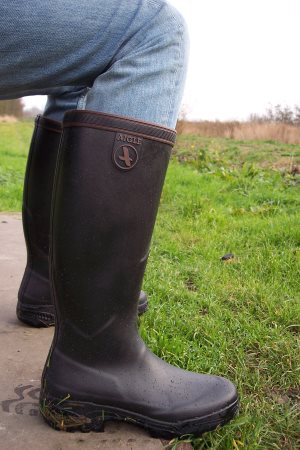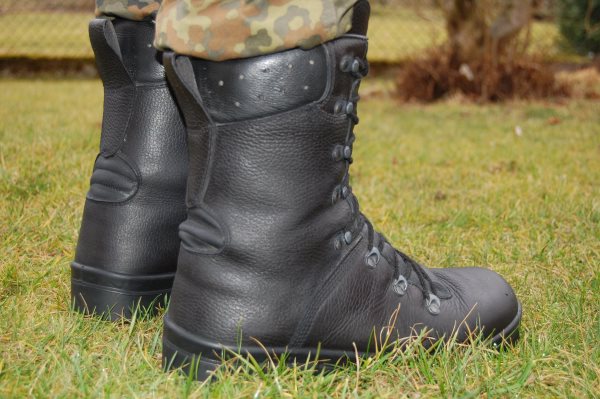When it comes to picking hunting boots, the one-size-fits-all simply doesn’t work. Different terrains and weather conditions call for boots with specific features. The ideal situation would be where you possess a different pair of boots for each condition. Sadly, not all of us can afford that. Now, you must be wondering how to choose the best hunting boot and what aspects you need to consider. Well, you have come to the right place. This article attempts to answer all your questions. Here, I will tell you what features you must consider to find the ideal footwear for different conditions. Let’s get started.
The Type of Boots
There are several different types of boots with distinctive features. Here are some of the boots that you can choose from.
Rubber Boot
Waterproof and thus perfect for trekking through swamp areas or crossing creeks. Due to being scent-free, they are also ideal for bow hunting. As with a bow, you will need to shoot from 30-40 yards, and the scent-free feature is essential not to give your location away to the buck. That being said, rubber boots often leave a lot to be desired in ankle support and thus ill-suited for mountainous terrains. In addition, they are also deemed unsuitable for extreme cold weathers.
Upland Boots
If you are likely to stick to upland birds and hunt on only flat grassy lands, you should probably go for upland hunting boots. They are lightweight and comfortable making them the right fit for walking and stalking for hours on end.
Multi-Purpose Boot
Multi-purpose boots are a jack of all trades but master of none. Though suitable for different kind of terrains, they aren’t designed for any particular type of terrain. If you want to try out various kinds of terrains and keep your options open, multi-purpose boots should be your go-to choice.
Mountaineering Boot
Specifically designed for hunting on rocky, rugged, high elevation terrains. What makes them ideal for rugged terrains is their sturdy built providing superior ankle support. Besides, you will also be getting a lot of traction that provides balance and makes your feet stable on slippery terrains.
Snake Boot
Imagine going on a hunt and becoming the prey of a venomous snake! Terrible! Isn’t it? Getting bitten by a snake during a hunt isn’t a very uncommon phenomenon. And there’s no guarantee you won’t meet the same fate unless your footwear is snake-proof. Snake boots are made of a puncture-proof material that prevents the fangs from penetrating the boot. That’s why it’s imperative that you get a snake-proof boot while hunting in wild territory.
Insulation

Ankle Support
Hunting is a strenuous task often requiring long hours of constant and vigorous walking on harsh terrains. In such occasions, inappropriate footwear and lack of sufficient ankle support can cause blisters, ankle sprain, and similar problems. Therefore, you should invest in high-quality hunting boots that provide adequate ankle support. However, despite utmost caution, accidents can still happen. Thus, you’d do well to keep a first aid kit in your hunting backpack. I suggest you check out Backpack Reviewed if you’re in the market for a good one.
Weight
Getting the weight right is highly important. If you are on the prowl for a trophy bull or an elk, you will want your pair of boots to be as lightweight as possible. For every extra pound matters as they can slow you down and consequently increase the likelihood of returning empty-handed form the hunt. And what’s more, it’s also going to fatigue you quickly. Moreover, bulky shoes don’t let you feel the ground, which can be an issue while stalking. For you might accidentally snap a twig and scare the deer away. On the other hand, if you are going to do a lot of hiking and trek through slushy snow, look for a heavy pair of boots. They usually feature a stiff sole and won’t flex on nasty terrains such as Alaska.
Material
When it comes to material, you have a wide variety of options to choose from. However, most of the footwear contains more than one material for durability and better performance. In the past, leather used to be the most popular choice among the hunters. Although it has seen some decline in its popularity in recent years, a large number of hunters still prefer leather over others. Leather boots offer extensive protection to your feet, are durable, and can last years without any issues. Regarding mesh hunting boots, they are comparatively lighter than the leather ones and an appropriate fit for continuous stalking and walking. Even though mesh boots aren’t water-resistant, they get dry in no time. Rubber boots come with two distinct advantages; scent-free and waterproof. The scent-free feature is particularly helpful when ambushing a deer as you want to keep your presence hidden from the buck.
Traction
While hunting, you will come across some terrains which are incredibly slippery. In such terrains, the chances of hunting success and your safety hinges on how much traction it provides. Hence, the hunting footwear you choose must provide enough traction to guarantee slip-free movement. Otherwise, it could lead to a sprained ankle or some other kind of injury.
Waterproof
Nobody likes wet feet, especially while hunting. Not only it makes your feet incredibly uncomfortable but also makes hunting more difficult. That’s why your hunting boots must be completely water resistant. Make sure the boots feature gore-tex, which is a waterproof breathable membrane. Although hunter boots featuring gore-tex can be a bit expensive, they are worth the money. Constant movement can sometimes create heat and in turn moisture inside the boots, which makes running uncomfortable. The inclusion of moisture-wicking technology can eliminate the problem.
Fitting
Misfitting footwear can cause blisters and severe discomfort during the hunt. You can’t even take the shoes off while you are tramping through marshes chasing bucks. Consequently, soon the pleasure hunt turns into a nightmare. In contrast, boots that fit like gloves can go a long way in ensuring a successful and satisfying hunting experience. However, if you are buying for kids, get one size bigger so that they can grow into them.
Sole
Soft and flexible soles won’t just cut it on rocky terrain. To chase elk on nasty steep terrains, you need a rigid and strong sole. However, flexibility and softness are valued while hunting on an open prairie as they facilitate silent stalking. Go for an open sole pattern. They don’t clog up with muds and prevent the boots from getting heavy.
Height
The nature of hunting terrain determines the ideal height for you. If you are looking to do your hunting on an open field, I’d recommend you to go with the shorter boots. For short boots are most suited to upland hunting and chasing deer in the backcountry. In contrast, crossing a stream or chasing moose through the creeks require more protection for your feet. For that, you will need to get the longest hunting boots. In simpler words, if the condition is wet, choose longer boots; while for the dry and warm conditions, pick the shorter ones.
Durability
Imagine buying a pair of hunting boots and the first day you take it out its outer sole comes apart! Would you like that to happen to you? Surely, you don’t. Instead, you want something that will hold out for years or at the very least an entire hunting season. So, go for the durable ones even if they seem a bit pricey.
Price
Though there’s no point in breaking the bank for a pair of hunting boots, you don’t want to go cheap either. To be honest, expensive ones have great build quality, long-lasting sole, and better stitch quality. In short, the more money you invest, the better performance you will get.
Conclusion
Choosing the right footwear for hunting is no easy task. However, reading this article should give you an idea of what you need. Again, I have some homework for you. Write down the features that you need. Write down the features that you don’t need. Make a list of your preferences in material, type, and height.
Once you are done, you will know exactly which hunting boot is perfect for you.
If you have any further questions, please shoot them in the comments section.
[jbio template=”bootbomb0″]


0 comments